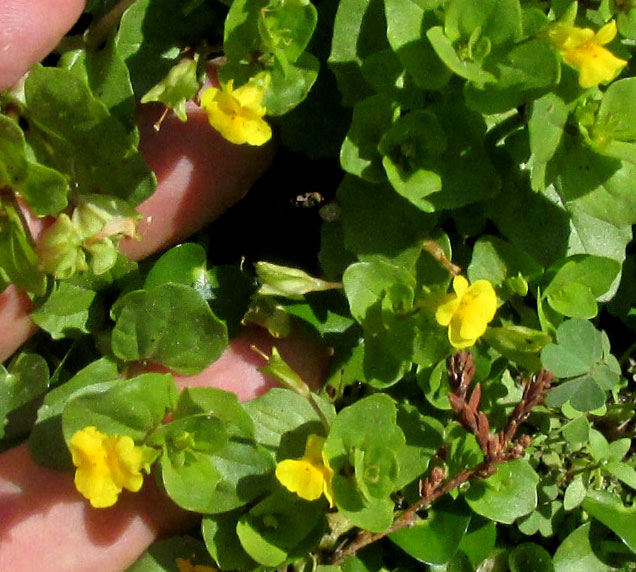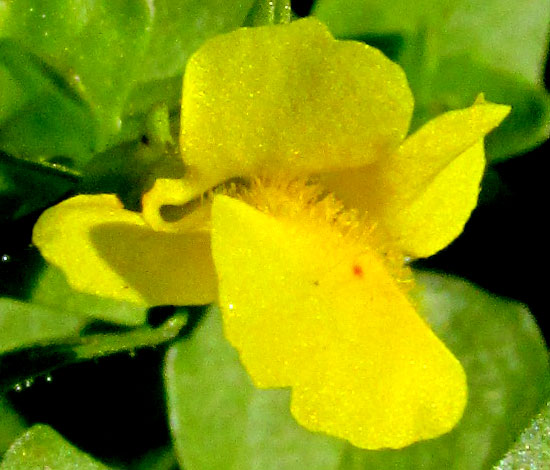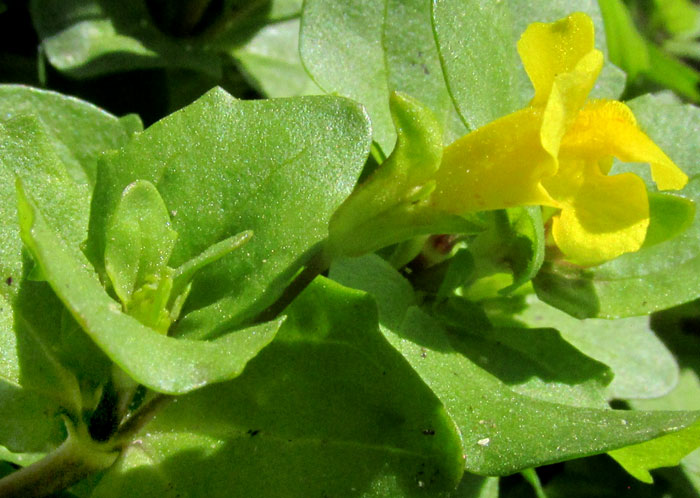Excerpts from Jim Conrad's
Naturalist Newsletter
entry dated May 21, 2022, notes from a camping trip among hills about 7kms ENE of Tequisquiapan, Querétaro state, MÉXICO
elevation about 2020m (6700 ft), near N20.57°, W99.85°
ROUND-LEAF MONKEYFLOWER

Here at the end of an especially dry dry-season the landscape is mostly gray and brown, except in those rare spots at the bases of cliffs and the heads of canyons where spring water seeps to the surface. In such spots a small but lush and green oasis forms, where all through the day birds and other animals come to drink, and plant species turn up not found out in the sunbaked scrub. One of those species, forming a thick, lush carpet in a water-saturated low spot below the cliff, is shown above.
These plants stayed close to the wet soil, rooting at nodes along their stems. Note the leaves' roundish shape, and the low, weak teeth along some of their margins. Up close, the flower had a definite snapdragon-blossom look:

The broad lower lip is hitched up on one side, but other flowers didn't do that. The lower lip also has a single reddish spot on it, which later I learned is a feature of this species, though often it's much more than a single spot.

Above, from the side, the blossom displays a thick corolla tube, also similar to snapdragon flowers.
I'd met low-growing species with such yellow flowers before. For example in 2009, in Oregon, there was the Yellow Monkeyflower, so I figured that this was one of the many, widely distributed monkeyflower species in the genus Mimulus of the Snapdragon Family, the Scrophulariaceae. However, once I began "doing the botany," this educated guess ran into trouble.
The first problem was that the Flora del Bajío, which covers this part of semiarid upland central Mexico, didn't have any Mimulus species in its Snapdragon Family volume, though surely monkeyflower species exist here. Eventually the Bajío's monkeyflower species turned up in the 2012 volume of the Flora documenting the region's members of the Lopseed Family, the little-known Phrymaceae. There, our plants were easily determined to be Mimulus glabratus, often known in English as the Round-leafed Monkeyflower.
Once again results from genetic sequencing have switched a number of plants from a family where physical characteristics indicate they should belong, to a family that, without the genetic evidence, it seems unreasonable to put them there.
Plus, in 2012, Guy Nesom published his "Taxonomy of Erythranthe Sect. Simiola (Phrymaceae) in the USA and Mexico," in which the Bajío Flora's Mimulus glabratus was renamed ERYTHRANTHE GLABRATA.
In the long run I think these shiftings will all make sense and the structure of the newly constructed and deconstructed families will be more aesthetically pleasing, and keep reminding us of ancient mutations that enabled new lines of organisms to emerge, and proliferate. But right now everything is a blur as we rethink traditional concepts. However, that's exactly what humanity needs to do at all levels if we ourselves are to survive on Earth.
Erythranthe glabrata, as configured now, occurs in a great variety of moist to wet environments over a broad range of elevations, and is distributed in two widely separated regions. It's native from northwestern Mexico south through here to Guatemala, then disappears from the rest of Central America, but reappears in Colombia in South America. In Colombia, S. Cordero and others at the Rizoma Centro de Estudios Agroecológicos y Botánicos report many uses of the plant, including eating the stems and leaves in salads and soups, and making a refreshing drink. Cattle gladly forage on it, and medicinally it's used to alleviate chronic liver and lung problems, to deal with indigestion, and drinks can be made from it to lower the fever.